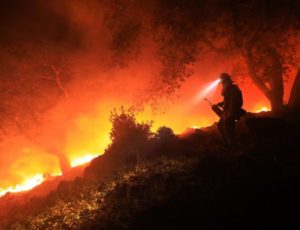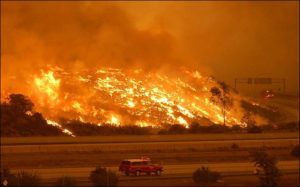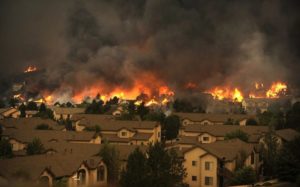Wildfire
 Some of the golden hills of California just turned black. This time it is north around Santa Rosa and the wine country. Usually it is the San Gabriel mountains or other Southern California areas. The conditions leading to destructive wildfire are the same. There are essentially two seasons; when it rains and when there is no rain.
Some of the golden hills of California just turned black. This time it is north around Santa Rosa and the wine country. Usually it is the San Gabriel mountains or other Southern California areas. The conditions leading to destructive wildfire are the same. There are essentially two seasons; when it rains and when there is no rain.
This year there was a lot of rain in what passes for winter in all of California. Everything greens up and grows. It means good feed for cattle, and lots of fuel in the fall when it dries out. You are probably familiar with the Santa Ana winds in Southern California. The desert Great Basin east of the mountains cools off, creating an area of high pressure. The pressure creates west-flowing winds, blowing to the coast. As the winds hit the mountains, they rise, cool, then flow down the west side of the mountains, warming as they flow west. Thus the Santa Ana winds, hot dry wind flowing west and drying all that foliage that grew during the rainy season.
In Northern California, the winds are called Diablo winds, after the local Diablo mountains. The high pressure west of the coastal region originates from high pressure following storms blowing into the basin from the stormy northwest. The high pressure again creates west flowing wind howling down the west side of the mountains. The fires are set or lightning started, and burn across the valleys. That means the golden hills, vineyards, and Santa Rosa suburbs.
The fire triangle: fuel, heat, and oxygen. The fuel grew, much heat comes with the wind, which also supplies plenty of oxygen. Add an ignition point, and it burns. The wind and fire blows down canyons, and people like to live in the canyons. When all the space in the canyons is full, people move into the hills. It is called the urban-wildland interface. The entire American West is growing in population, and the new people moving in want to experience some open space. The open space is open because it periodically burns, thus no forest, just chaparral and grassland. And houses. Destruction.
Is climate change partly responsible? You decide. California has always had destructive fire blowing in from the west, but is climate change exacerbating the natural phenomena?
Here in Colorado, we also have destructive wildland fires fanned by downslope winds. Here the winds are from the west, hit the mountains, rise, cool, and roar down the eastern side of the mountains, fanning fires. People are moving into the areas where the fires have always burned, and their houses burn. The Plains east of Denver see huge grassland fires, especially after a wet spring.
Western Colorado also has wind accelerated fires. Westerly winds encounter the west side of the Rockies, rise, cool, and descend into the area around Glenwood Springs. The country is the Colorado equivalent of California Chaparral. The brush burns got, killing firefighters and threatening towns. It is only a matter of time before things get hot in Glenwood, Newcastle, and Carbondale.
The West is a wonderful place, with open space, mountains, deserts, and a harsh climate. People moving there beware, the conditions are more violent than in the well-watered East. Oh, and don’t forger the landslides and avalanches where it is steep, along with fire. There is lots of steep country. There is steep country just west of all the people living along the Front Range. The fires just might burn into town, just like Santa Rosa.
Colorado Springs has seen fire, along with Boulder. Some day a fire may want to go downtown in a Front Range city. It is also likely a mountain town like Evergreen or Estes Park will burn. The Mountain Pine Beetle has left a lot of standing dead trees ready to burn.
Why do I seem to be writing about fire, earthquakes, hurricanes, and other means of destruction? Maybe because I am confronting my own mortality. I just turned 75. I know it is surprising because I look so young.

